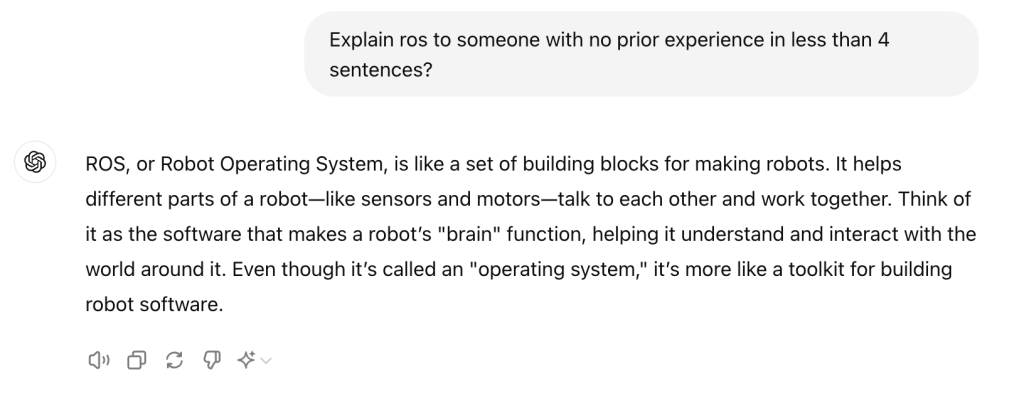Before reading this article, take a second to think about the hardest search you’ve worked on this year… Ok, now that we’re all on the same page. Mine was a Robotics Software Engineer for a startup. Although I’ve been a technical recruiter for 8+ years and worked on what feels like every technology stack out there, this was an area that hasn’t been too common for me. Below are the steps I took to successfully place two candidates.
Let’s get started!
Documentation
In order to keep my searches and candidates organized, I used Google sheets throughout the search. It’s easy to create separate tabs for boolean searches, competitors, outreach messages, and even certain candidates at competing companies.
Search Kickoff
After reviewing the job description, I used ChatGPT to give me a refresher on ROS (Robotic Operating System) and other areas of robotics development, such as SLAM and perception.

Prior to the intake meeting, it’s good practice to run an initial search. By doing so, I was better prepared to answer manager questions and had a better understanding of how difficult the search may be; this allowed me the ability to provide suggestions and feedback immediately. Based on my experience working in the Atlanta area, I suspected the talent pool for this position would be on the smaller side. My assumption proved right after a LinkedIn Recruiter search yielded 36 candidates (this was prior to any exclusion criteria like years of experience or education requirements). As a note, LinkedIn Talent Insights could also be utilized here. Once I saw the size of the talent pool, I was able to direct the conversation with the hiring manager to consider providing a relocation budget. Spoiler: One candidate was relocated by the team after accepting an offer.
Sourcing
After a successful meeting with the manager, it was time to kick off the search. Below are all tools that I utilized to find the best possible candidates.
- ChatGPT (free version)
- ChatGPT was utilized in a few different ways during this search. First, I had it create a list of the top 25 universities in the USA for Robotics. Then I had it develop a boolean search from that list. To help with candidate screenings, ChatGPT was also asked to develop five interview questions with answers. These questions and answers were used during candidate screening calls to determine a baseline level of knowledge.
- CSRankings.org
- CS Rankings is a website where users are able to sort and filter universities based on certain criteria such as number of publications in a specified year range and specialty area. I filtered by Robotics and created a boolean search based on the list of universities that resulted. The website also has links to professor’s pages which, more often than not, include their contact information. Occasionally, group projects list other collaborators which provide additional people to contact.
- Google Searches
- I used the site operator [site:edu “robotics club” “#school name”] and the more general [site:edu “robotics club” president | leadership] to find universities that had robotics clubs. This search yielded a pool of current students in robotics clubs. Oftentimes, these clubs have member lists that include Master’s or PhD members and a link to alumni profiles.

Social Media
- I leveraged this airtable list to find Slack channels where the role could be advertised. I selected Tech404, which is an Atlanta based tech group with a specific channel for posting jobs.
- Discord has a list of servers but I ultimately didn’t join any of them. Instead, I utilized Layoffs.fyi, a website that lists company layoff announcements and compiles the names of those who have been impacted in a layoff.
- After a quick google search, I found a list of robotics award winners. This list gave me direct competitors to target in my search.
- By once again using the ‘site operator,’ I was able to find Meetup groups for robotics enthusiasts. [site:meetup.com robotics]. I created a Meetup.com account and joined various groups of robot enthusiasts to cross reference with their professional profiles.
RecruitBot (paid tool)
- RecruitBot uses AI to identify candidates from keywords or an uploaded job description. This expanded the search to identify candidates that previous searches hadn’t originally uncovered.
Brian Fink’s Programmable Search Engine
- This is a programmable search engine that Brian Fink showed people how to build at a past SourceCon. Essentially a PSE is a custom search engine where you’ve set parameters. This one searches for Github profiles, diverse candidates, resumes, email addresses, and more.
LinkedIn Recruiter
- I couldn’t leave out the blue devil ;). By developing a well rounded search with knowledge gained from alternative sources, I was able to utilize LinkedIn to its full potential. What initially started out as 36 profiles steadily grew as I applied each alternative search method to write boolean strings that incorporated the additional skills, experiences, and educational achievements I learned during each step.
Ultimately, there were two candidates hired by this company that were found through LinkedIn; although it would not have happened as quickly, or possibly at all, if the other search methods had been omitted. The next time you have a challenging search, remember to reboot your strategy a few times with new ideas!
